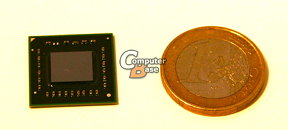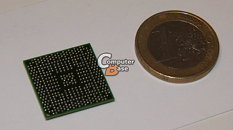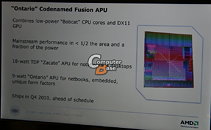Friday, September 3rd 2010

AMD's Fusion ''Ontario'' APU Chip Pictured
At the ongoing IFA event in Berlin, AMD displayed one of the first derivatives of its Bobcat low-power x86 processor architecture, codenamed "Ontario". This Fusion APU (accelerated processing unit), which is a combination of an x86 CPU and a DirectX 11 compliant GPU is built for low-power devices such as netbooks, handhelds, and tablets. AMD also showed off the chip package itself, which is roughly the size of a 1 Euro coin. The package, like AMD's mobile Athlon/Phenom processors, has no integrated heatspreader (IHS), but like the Intel Atom, uses a ball-grid array (BGA) to permanently fix itself to the system board.
AMD claims that the chip offers "mainstream performance" at less than half the die area (in this case, below 100 mm²), and a fraction of the power. Speaking of which, the "Ontario" Fusion APU has a TDP of 9W, while a higher-performance APU codenamed "Zacate", which is probably competitive with Intel's CULV processors, and is built for ultra-thin notebooks, nettops and slim all-in-one PCs, has a TDP of 18W. AMD claims that the two will ship (to OEMs, because these are not end-user products) in Q4 2010. For the desktop, AMD is developing the "Llano" Fusion APUs that are of a different form-factor and package altogether.
Source:
Computerbase.de
AMD claims that the chip offers "mainstream performance" at less than half the die area (in this case, below 100 mm²), and a fraction of the power. Speaking of which, the "Ontario" Fusion APU has a TDP of 9W, while a higher-performance APU codenamed "Zacate", which is probably competitive with Intel's CULV processors, and is built for ultra-thin notebooks, nettops and slim all-in-one PCs, has a TDP of 18W. AMD claims that the two will ship (to OEMs, because these are not end-user products) in Q4 2010. For the desktop, AMD is developing the "Llano" Fusion APUs that are of a different form-factor and package altogether.



38 Comments on AMD's Fusion ''Ontario'' APU Chip Pictured
Steve selling will be like, "...this new iPhone will boast more graphical power than any phone or portable device this size. Full 1080p output to an TV via a simple HDMI cable. *Unneeded applause for something several others have already done*. This chip is a revolution in technology. A true innovation. *Que Apple logo on screen to take credit with "brought to you by" tag so AMD doesn't get pissed*. Let me just show you why you should want a new iPhone 5. *live demo of 1080p out of some Disney/Pixar film through iTunes....which is only 720p, but Steve doesn't give a shit*......"
apple doesnt make hardware, they buy it, slap their own shell and software around it and sell it off.
X86 isnt suitable for small handsets, but certanly arm arch by amd is possible, they just need to licence and build!
Good too, cause they couldn't afford to have another dud, not after so long without a new architecture.
@Imsochobo: your english is eye-wateringly hard to try and understand, but your internet speeds make me just wanna cry!
However, the die sizes don't really match up, since the Ontario APU is reported as having the same size as Cedar and they're both built using TSMC's 40nm.
What I think as a possibility is that the Ontario's GPU is based around the rumoured shader model for the 6000 series, which uses 4-way shaders instead of 5 and decreases the shader count by 25% while offering 98% of older model's performance.
Therefore, Ontario could actually sport a 64-shader IGP (therefore, making it an integrated Caicos - HD6350) with roughly the same performance as a discrete HD5450, clock-for-clock.
Clock it decently and it could even stand up to ION 2 systems in gaming performance.
Edit: Done. They don't make hardware no more. I thought when they said "holdings" it would be companies they at least partially owned. Instead I find that they are all licensed out sourcing. While some of these companies dedicate entire factories and/or departments to producing Apple parts, and Apple has a large say in final product, they do not have real control over the companies.
Therefore, Ontario could actually sport a 64-shader IGP (therefore, making it an integrated Caicos - HD6350) with roughly the same performance as a discrete HD5450, clock-for-clock.
interesting so if what u say is correct then they could have a 1280shadder gpu match a 5870:rolleyes:
and a 1600 one with 25% perfomance lead at the same clock:D interesting really:toast:;)
All that AMD has to do is increase core clocks do ~950MHz, increase memory bandwidth, add more tesselator units and they'll have a card that surpasses GTX480 in every possible gaming situation.
They don't need to add more shaders, we can see that in the HD5850->HD5870 clock-for-clock comparison.